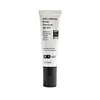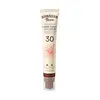What's inside
What's inside
 Key Ingredients
Key Ingredients

 Benefits
Benefits

 Concerns
Concerns

 Ingredients Side-by-side
Ingredients Side-by-side

Octocrylene 4.9%
UV AbsorberEctoin
Skin ConditioningAvena Sativa Bran Extract
AbrasiveBisabolol
MaskingButylene Glycol
HumectantButyloctyl Salicylate
Skin ConditioningCaffeine
Skin ConditioningCaprylyl Methicone
Skin ConditioningCitrus Aurantium Dulcis Peel Extract
Emulsion StabilisingCyclopentasiloxane
EmollientEthyl Ferulate
AntioxidantEthylhexylglycerin
Skin ConditioningHydroxyethyl Acrylate/Sodium Acryloyldimethyl Taurate Copolymer
Emulsion StabilisingOctyldodecyl Neopentanoate
EmollientOleth-3 Phosphate
PEG-7 Trimethylolpropane Coconut Ether
EmulsifyingPhenoxyethanol
PreservativePolyisobutene
Propanediol
SolventSilybum Marianum Seed Extract
Skin ConditioningSodium Hyaluronate
HumectantSodium Stearoyl Glutamate
CleansingTocopheryl Acetate
AntioxidantTriethoxycaprylylsilane
Water
Skin ConditioningOctocrylene 4.9%, Ectoin, Avena Sativa Bran Extract, Bisabolol, Butylene Glycol, Butyloctyl Salicylate, Caffeine, Caprylyl Methicone, Citrus Aurantium Dulcis Peel Extract, Cyclopentasiloxane, Ethyl Ferulate, Ethylhexylglycerin, Hydroxyethyl Acrylate/Sodium Acryloyldimethyl Taurate Copolymer, Octyldodecyl Neopentanoate, Oleth-3 Phosphate, PEG-7 Trimethylolpropane Coconut Ether, Phenoxyethanol, Polyisobutene, Propanediol, Silybum Marianum Seed Extract, Sodium Hyaluronate, Sodium Stearoyl Glutamate, Tocopheryl Acetate, Triethoxycaprylylsilane, Water
Butyl Methoxydibenzoylmethane 2.7%
UV AbsorberHomosalate 6%
Skin ConditioningEthylhexyl Salicylate 4.5%
UV AbsorberOctocrylene 4.5%
UV AbsorberWater
Skin ConditioningSilica
AbrasivePropylene Glycol
HumectantCetyl Dimethicone
EmollientPhenoxyethanol
PreservativeMica
Cosmetic ColorantSodium Polyacrylate
AbsorbentAcrylates/C12-22 Alkyl Methacrylate Copolymer
Caprylyl Glycol
EmollientParfum
MaskingChlorphenesin
AntimicrobialGlycerin
HumectantDisodium EDTA
Aloe Barbadensis Leaf Juice
Skin ConditioningSodium Hyaluronate
HumectantHibiscus Sabdariffa Flower Extract
Skin ConditioningCarica Papaya Fruit Extract
Skin ConditioningMangifera Indica Fruit Extract
Skin ConditioningPassiflora Incarnata Fruit Extract
Skin ConditioningPlumeria Acutifolia Flower Extract
Skin ConditioningPsidium Guajava Fruit Extract
AstringentTitanium Dioxide
Cosmetic ColorantButyl Methoxydibenzoylmethane 2.7%, Homosalate 6%, Ethylhexyl Salicylate 4.5%, Octocrylene 4.5%, Water, Silica, Propylene Glycol, Cetyl Dimethicone, Phenoxyethanol, Mica, Sodium Polyacrylate, Acrylates/C12-22 Alkyl Methacrylate Copolymer, Caprylyl Glycol, Parfum, Chlorphenesin, Glycerin, Disodium EDTA, Aloe Barbadensis Leaf Juice, Sodium Hyaluronate, Hibiscus Sabdariffa Flower Extract, Carica Papaya Fruit Extract, Mangifera Indica Fruit Extract, Passiflora Incarnata Fruit Extract, Plumeria Acutifolia Flower Extract, Psidium Guajava Fruit Extract, Titanium Dioxide
 Reviews
Reviews

Ingredients Explained
These ingredients are found in both products.
Ingredients higher up in an ingredient list are typically present in a larger amount.
Octocrylene protects skin from sun damage. It absorbs UV-B with peak absorption of 304 nm. It is a common sunscreen ingredient and often paired with avobenzone, a UVA filter. This is because octocrylene stabilizes other sunscreen ingredients by protecting them from degradation when exposed to sunlight. Octocrylene is a photostable ingredient and loses about 10% of SPF in 95 minutes.
Octocrylene also acts as an emollient, meaning it helps skin retain moisture and softens skin. It is oil-soluble and hydrophobic, enhancing water-resistant properties in a product.
Those who are using ketoprofen, a topical anti-inflammatory drug, may experience an allergic reaction when using octocrylene. It is best to speak with a healthcare professional about using sunscreens with octocrylene.
The EU allows a maximum of these concentrations:
Learn more about OctocrylenePhenoxyethanol is a preservative that has germicide, antimicrobial, and aromatic properties. Studies show that phenoxyethanol can prevent microbial growth. By itself, it has a scent that is similar to that of a rose.
It's often used in formulations along with Caprylyl Glycol to preserve the shelf life of products.
Sodium Hyaluronate is hyaluronic acid's salt form. It is commonly derived from the sodium salt of hyaluronic acid.
Like hyaluronic acid, it is great at holding water and acts as a humectant. This makes it a great skin hydrating ingredient.
Sodium Hyaluronate is naturally occurring in our bodies and is mostly found in eye fluid and joints.
These are some other common types of Hyaluronic Acid:
Learn more about Sodium HyaluronateWater. It's the most common cosmetic ingredient of all. You'll usually see it at the top of ingredient lists, meaning that it makes up the largest part of the product.
So why is it so popular? Water most often acts as a solvent - this means that it helps dissolve other ingredients into the formulation.
You'll also recognize water as that liquid we all need to stay alive. If you see this, drink a glass of water. Stay hydrated!
Learn more about Water